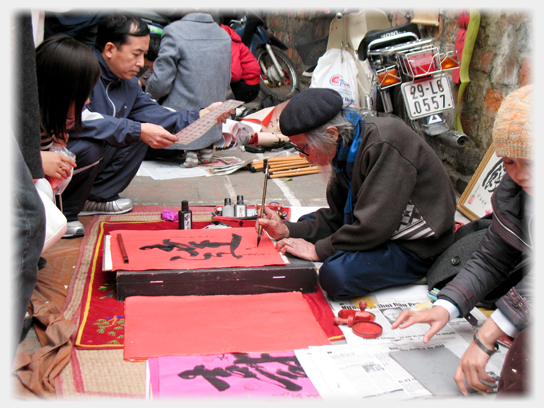
|
Chinese Characters
For over a thousand years Latin offered Europeans the possibility of communicating irrespective of their native languages. Because academic educations included a reasonable level of mastery of Latin, whatever the content of further study, an exchange of ideas with foreign scholars was possible. This is a position that has also been held by French and by Sanskrit, and is now held by English, which has become first or second language to over a billion people. Those languages unite their verbal and written forms; we learn both, and communicate using both.
By contrast in the Far East the lingua franca is purely written, it too is used by over a billion people who speak dozens of languages mutually unintelligible to one another. In this respect the picture above is a little disingenuous for in Hà Nội few of the people in those queues will understand any of the characters being written. The break with written Chinese occurred in Vietnam over a hundred years ago, until which time they too had used a form of the Chinese system called Nôm which could often be understood by the Chinese reader. So the picture is in a sense anachronistic, but serves to point to the arguments about the relationship between thought and word.
An
ideogram
expresses an idea essentially without reference to the sounds of a language. The written symbol ‘5’ can be understood almost anywhere without any worry about what language the perceiver uses. The sounds we utter, or the 'sounds' we make internally on seeing the number, are quite separate from the function and meaning of the number. So too to some extent with Chinese characters. If we venture to learn a little written Chinese we are likely to meet the sun
![]() and the moon
and the moon
![]() early on. These work just like 5, and are only different in being less familiar; our own spoken languages are irrelevant, these 'signs' can mean the same for all of us. Although unlike ‘5’ they are not about abstractions, but in their concreteness more about where nature has been cut at her joints by language–very physical discreet
objects.
early on. These work just like 5, and are only different in being less familiar; our own spoken languages are irrelevant, these 'signs' can mean the same for all of us. Although unlike ‘5’ they are not about abstractions, but in their concreteness more about where nature has been cut at her joints by language–very physical discreet
objects.
The story of this
development
is told lucidly by Cecilia Lindqvist
(1989).
Among her rich discussion of many hundreds of characters she introduces sun and moon. The earliest evidence of these comes from etchings on bones.
 Here the first figure shows early forms of sun. From these we can see how the modern character, through the use of a brush, inherits the form. Moon shows a similar development,
Here the first figure shows early forms of sun. From these we can see how the modern character, through the use of a brush, inherits the form. Moon shows a similar development,
 its early forms are shown in the figure to the right. Again, if we imagine converting it to brush strokes, we
have the modern character.
its early forms are shown in the figure to the right. Again, if we imagine converting it to brush strokes, we
have the modern character.
Above there was a caveat: ‘to some extent’ sound is separate. It is a big but, and a hundred years ago Ezra Pound famously overlooked this qualification. When publishing Ernest Fenollosa’s book ‘The Chinese Written Character as a Medium for Poetry’, (Saussay, 2008). he saw most of written Chinese as ideographic. In that book Pound and Fenollosa argue that the resulting concreteness of the characters is central to the strength of the poetry. Chinese characters do indeed sometimes help us renounce abstraction, but it is only sometimes, and this is a rather partial story of Chinese writing.
At the beginning of the time of the use of these characters there appear to have been some 400 of them, these were then compounded to give a further 1,200 or so ideograms. This is insufficient for a written language to go far. In due course these basic items were supplemented with phonetic elements. New characters for other concepts were formed by using the combination of one of the old basic elements plus a phonetic part from a particular spoken language.
So today, modern Chinese characters retain this mixture, with the great majority having a phonetic component and a long history of phonetic connotations. While those connotations vary greatly between speakers, there is still a core of elements accessible to a large number of languages. This allows a rich world of artistic expression from which those of us who cannot read the characters are barred. In the world of eastern calligraphy meaning may emerge quite independently of sounds and languages. Vision and meaning take on a new relationship, and allow us to see just how divorced these concepts can be: the internal monologue is only one mode of thinking–there is no need to have language in order to think.
References
- Saussay, Haun, Stalling, Jonathan, and Klein, Lucas (2008) (Ed) ‘The Chinese Written Character as a Medium for Poetry’ Fordham Universtiy Press, New York.
- Lindqvist, Cecilia (1989) ’China: Empire of Living Symbols’ Da Capo Press, Philadelphia.
30th September 2012 ~ 2nd October 2015